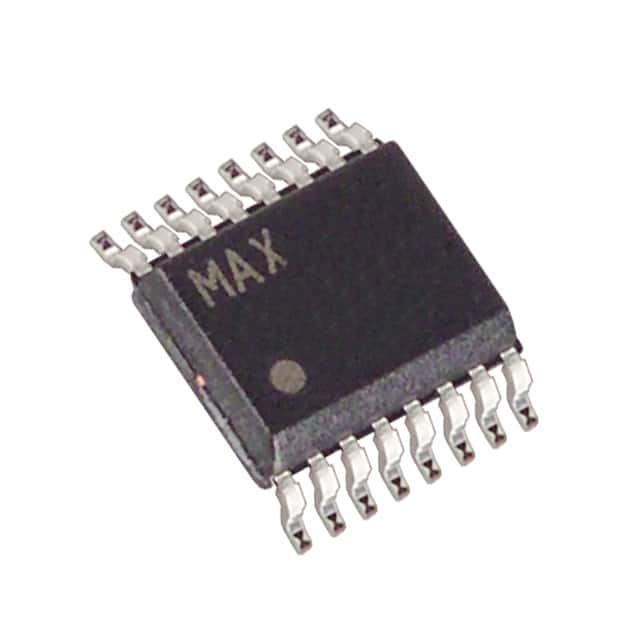MAX534ACEE+T
Product Overview
- Category: Integrated Circuit (IC)
- Use: Digital-to-Analog Converter (DAC)
- Characteristics: High precision, low power consumption
- Package: 16-pin TSSOP (Thin Shrink Small Outline Package)
- Essence: Converts digital signals into analog voltages
- Packaging/Quantity: Tape and reel, 2500 units per reel
Specifications
- Resolution: 12 bits
- Number of Channels: 1
- Supply Voltage Range: +2.7V to +5.5V
- Operating Temperature Range: -40°C to +85°C
- Output Voltage Range: 0V to Vref
- DNL (Differential Non-Linearity): ±0.5 LSB (Least Significant Bit)
- INL (Integral Non-Linearity): ±1 LSB
- Power Consumption: 0.5mW (typical)
Pin Configuration
The MAX534ACEE+T has a total of 16 pins arranged as follows:
- VDD - Positive supply voltage
- AGND - Analog ground
- REF - Reference voltage input
- DGND - Digital ground
- DIN - Digital input data
- SCLK - Serial clock input
- CS - Chip select input
- LDAC - Load DAC input
- VOUT - Analog output voltage
- NC - No connection
- NC - No connection
- NC - No connection
- NC - No connection
- NC - No connection
- NC - No connection
- VSS - Negative supply voltage
Functional Features
- High-resolution digital-to-analog conversion
- Low power consumption for energy-efficient applications
- Wide operating voltage range allows compatibility with various systems
- Serial interface for easy integration with microcontrollers
- Internal voltage reference for accurate conversion
Advantages and Disadvantages
Advantages
- High precision output with low differential and integral non-linearity
- Compact package size for space-constrained designs
- Low power consumption extends battery life in portable devices
- Easy integration with microcontrollers through the serial interface
Disadvantages
- Limited to single-channel analog output
- Requires an external reference voltage source
- Not suitable for applications requiring multiple simultaneous conversions
Working Principles
The MAX534ACEE+T is a digital-to-analog converter that converts binary digital signals into corresponding analog voltages. It utilizes a 12-bit resolution to provide high precision output. The input digital data is received through the DIN pin and synchronized with the SCLK signal. The CS pin is used to select the device, and the LDAC pin is used to load the DAC output simultaneously.
The internal voltage reference (VREF) sets the maximum output voltage range. The digital input data is converted into an analog voltage proportional to the input value. The resulting analog voltage appears at the VOUT pin, which can be connected to external circuitry for further processing or utilization.
Detailed Application Field Plans
The MAX534ACEE+T is commonly used in various applications where precise analog voltage generation is required. Some of the potential application fields include:
- Audio Equipment: Providing accurate analog audio signals for amplifiers, mixers, and equalizers.
- Industrial Automation: Generating control signals for motor speed control, valve positioning, and sensor calibration.
- Test and Measurement Instruments: Producing precise reference voltages for calibration purposes.
- Communication Systems: Generating analog signals for modulation and demodulation processes.
- Medical Devices: Providing accurate control voltages for medical imaging equipment and laboratory instruments.
Detailed and Complete Alternative Models
- MAX532ACWE+T: 12-bit DAC with dual-channel output and a different package (16-pin SOIC).
- MAX5380LATE+: 12-bit DAC with integrated voltage reference and serial interface (20-pin TQFN).
- LTC2631-HM12#PBF: 12-bit DAC with I2C interface and internal reference (10-pin MSOP).
These alternative models offer similar functionality but may have different features, package options, or interface protocols.
قم بإدراج 10 أسئلة وإجابات شائعة تتعلق بتطبيق MAX534ACEE+T في الحلول التقنية
Sure! Here are 10 common questions and answers related to the application of MAX534ACEE+T in technical solutions:
Q: What is the MAX534ACEE+T? A: The MAX534ACEE+T is a precision, low-power, 12-bit digital-to-analog converter (DAC) that can be used in various technical applications.
Q: What is the operating voltage range of MAX534ACEE+T? A: The operating voltage range of MAX534ACEE+T is typically between 2.7V and 5.5V.
Q: What is the resolution of MAX534ACEE+T? A: MAX534ACEE+T has a resolution of 12 bits, which means it can provide 4096 different output voltage levels.
Q: What is the typical output voltage range of MAX534ACEE+T? A: The typical output voltage range of MAX534ACEE+T is 0V to Vref, where Vref is the reference voltage supplied to the DAC.
Q: Can MAX534ACEE+T operate in both single-ended and differential modes? A: Yes, MAX534ACEE+T can operate in both single-ended and differential modes, providing flexibility in various applications.
Q: What is the maximum settling time of MAX534ACEE+T? A: The maximum settling time of MAX534ACEE+T is typically 10µs, ensuring fast and accurate voltage outputs.
Q: Does MAX534ACEE+T have any integrated features for power management? A: Yes, MAX534ACEE+T includes a power-on reset circuitry that ensures proper initialization during power-up.
Q: Can I control MAX534ACEE+T using a microcontroller or digital interface? A: Yes, MAX534ACEE+T has a standard 3-wire serial interface (SPI) that allows easy control and communication with microcontrollers.
Q: What is the temperature range in which MAX534ACEE+T can operate? A: MAX534ACEE+T can operate within a temperature range of -40°C to +85°C, making it suitable for various environments.
Q: Are there any evaluation boards or reference designs available for MAX534ACEE+T? A: Yes, Maxim Integrated provides evaluation kits and reference designs that can help users quickly prototype and integrate MAX534ACEE+T into their technical solutions.
Please note that these answers are general and may vary depending on the specific datasheet and application requirements.


